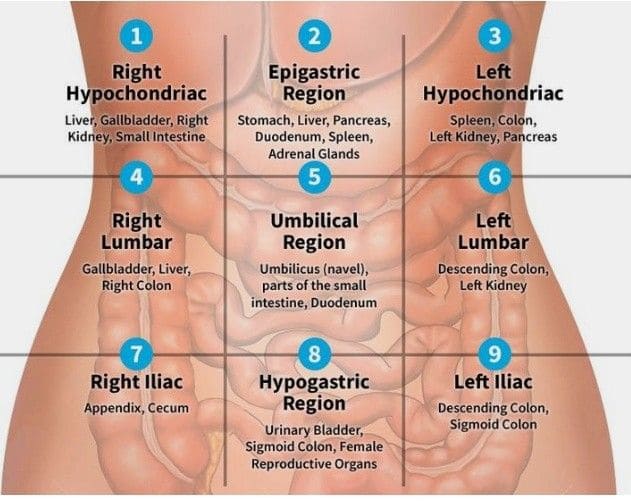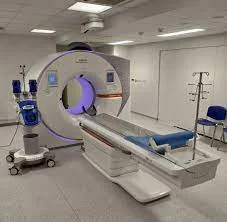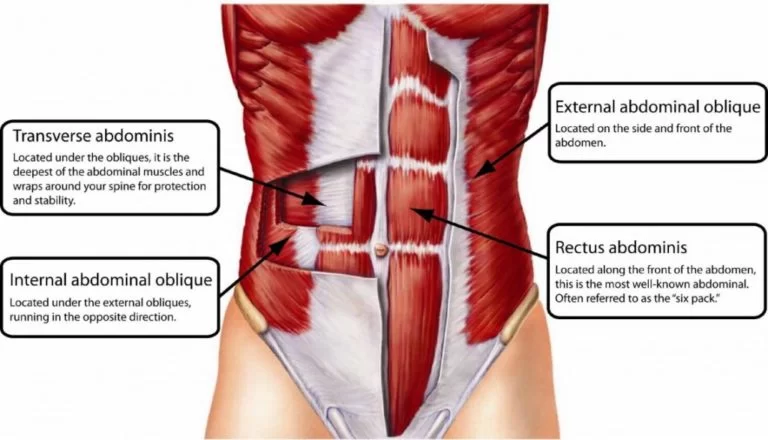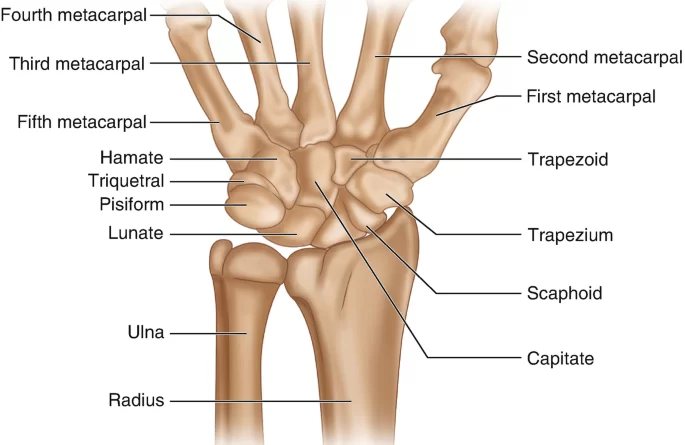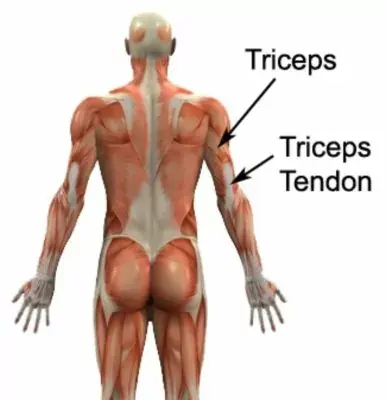Abdominal Regions
What is an Abdominal Region?
The abdomen is a crucial region of the human body, housing several vital organs responsible for digestion, excretion, and reproduction. Understanding its anatomical structure and organization into regions is fundamental in medical sciences for diagnostic and clinical purposes.
Abdominal regions are commonly divided into nine quadrants or regions for descriptive and clinical purposes. These divisions help healthcare professionals to localize and communicate findings accurately during physical examinations, medical imaging, and surgeries. Each region encompasses specific organs and structures, aiding in the diagnosis of various abdominal disorders and diseases.
You will learn how to categorize the abdomen into nine distinct sections and four distinct quadrants in anatomy and physiology. This is something you will utilize on an everyday basis when completing abdominal examinations (and while documenting) if you intend to pursue a career in healthcare like nursing.
In vertebrates, including humans, the abdomen is the area between the pelvis (pelvic brim) and the thorax (thoracic diaphragm).
For the purpose of description, the abdomen can be split into nine divisions or zones.
Anatomical regions of the Abdomen
The abdomen is made up of several anatomical sections, each of which has a distinct interior and boundary. Hesselbach’s triangle, the peritoneum, the inguinal canal, Calot’s triangle, and the abdominal cavity are all involved.
The muscles in the belly give the spine stability and protect the important organs beneath. The body bends at the waist with the help of these abdominal muscles.
The Four Abdominal Quadrants
First, let’s look at the four quadrants, which are created by the intersection of the transverse (or horizontal) plane—also known as the transumbilical plane—and the median (or midsagittal) plane.
Because they are composed of the left upper quadrant (LUQ), left lower quadrant (LLQ), right upper quadrant (RUQ), and right lower quadrant (RLQ), the four quadrants are simple to recall.
Two key points to keep in mind when using these four quadrants are as follows:
When performing assessments, you will use the navel, also known as the belly button, as a reference to help you see these quadrants. The intersection of the two planes is located here.
The meanings of “left or right” and “upper or lower” are always understood in relation to the anatomical position, not from your viewpoint. Remember that most students make the error of confusing their left and right regions, so be careful not to do so.
Major Organs in the Four Quadrants
The following are some of the principal organs located in each of the four abdominal quadrants:
- Right upper quadrant: The right upper quadrant contains the liver, stomach, gallbladder, duodenum, right kidney, pancreas, and right adrenal gland.
- Left upper quadrant: The liver, stomach, pancreas, left kidney, spleen, and left adrenal gland are located in the Left upper quadrant.
- Right lower quadrant: Appendix, reproductive organs, and right ureter are located in the right lower quadrant.
- Left Lower Quadrant: the reproductive organs and the left ureter.
NOTE: Parts of the small and large intestines are located in each of the four quadrants.
The Nine Abdominal Regions
The two parasagittal (also known as midclavicular) planes that run along the center of the clavicle bones and the two transverse (horizontal) planes used by the nine abdominal regions split the abdomen into even smaller pieces.
The subcostal plane, which is the superior transverse plane, is situated directly beneath the ribs. The inferior transverse plane, or intertubercular plane, runs just inferior to the navel and intersects the pelvic tubercles.
Let’s start by discussing the right and left columns as they have the same name (differentiated by a left or right prefix) and have called the bones that are closest to them later on.
Consider that mastering the common prefixes and suffixes will be extremely helpful when learning anatomy, as they will come in handy again.
Left and Right Hypochondriac Regions: The word “hypo” refers to beneath or below. The term “chondritic” prefix refers to cartilage, specifically rib cartilage. This is the area of the abdomen that lies below the ribs when we combine them. You do possess a left and a right hypochondriac area.
Left and Right Lumbar Regions: The vertebrae in your lower back, which are the bones nearest to the lumbar area, are referred to as lumbar. That is the origin of the name of this area.
Both the left and right columns are now taken care of. Let’s now examine the abdominal areas in the center column. These sections, in contrast to those on the left and right side columns, are called based on their location within the stomach rather than the bones.
The term “epi” refers to above or over, and the word “gastric” refers to the stomach or belly. Thus, this is the area above and beyond the belly.
The nine regions include:
- Right hypochondriac region
- Epigastric region
- Left hypochondriac region
- Right lumbar region
- Umbilical region
- Left lumbar region
- Right iliac (inguinal) region
- Hypogastric (pubic) region
- Left iliac (inguinal) region
Umbilical Region: Your navel, also known as the umbilicus, is located in the umbilical region, making it very easy to remember. In addition to serving as a landmark for the intersections of the four quadrants, the navel can help you recall that the umbilical region sits in the center of the nine abdominal regions.
Hypogastric Region: As we already know, the word hypo means “below,” while the word gastric means “belly.” Thus, the region beneath the belly is known as the hypogastric region when we combine the two.
If you need a quick memory trick to help you remember the names of these sections, just keep in mind that the titles of the side columns are the same from top to bottom: hypochondriac, lumbar, and iliac (HLI). The epigastric, umbilical, and hypogastric regions (EUH) are those in the middle column. Keep this style in mind: Hector adores Isabel at all times.
Organs in the Nine Abdominal Regions
Let’s now examine some of the main organs that are present in each location. While most basic anatomy lecturers usually don’t want you to learn every organ’s location by heart, they do expect you to have a general grasp of where each organ is placed.
- Right Hypochondriac Region: This area contains parts of the small and large intestines as well as the liver, gallbladder, and right kidney.
- Epigastric Region: A portion of the liver, along with the stomach, pancreas, duodenum, spleen, and adrenal glands, are located in the epigastric area.
- Left Hypochondriac Region: The left hypochondriac area contains the spleen, large or small intestines, pancreas, stomach, and tip of the liver.
- Right Lumbar Region: This region contains parts of the small intestine, the right kidney, and the ascending colon.
- Umbilical Region: The umbilical region contains the small intestine, the duodenum, and the transverse colon.
- Left Lumbar Region: This region contains portions of the small intestine, left kidney, and descending colon.
- Right Iliac Region: The right iliac region contains the small intestine, ascending colon, cecum, and appendix.
- Hypogastric Region: The hypogastric area contains the reproductive organs, small intestine, bladder, and parts of the sigmoid colon.
- Left Iliac Region: This area contains portions of the small intestine, descending colon, and sigmoid colon.
Differential Diagnosis
Children
- gastroenteritis
- mesenteric adenitis
- Meckel’s diverticulitis
- intussusception
- Henoch–Schönlein purpura
- Lobar pneumonia
Adults
- regional enteritis
- renal colic
- perforated peptic ulcer
- testicular torsion
- rectus sheath hematoma
- pelvic inflammatory disease
- ectopic pregnancy
- endometriosis
- torsion/rupture of ovarian cyst
- appendicitis
Elderly
- diverticulitis
- intestinal obstruction
- colonic carcinoma
- mesenteric ischemia
- leaking aortic aneurysm
Clinical Significance
Divisions of the abdominal region are essential to several aspects of medical practice:
- Techniques for physical examinations: During physical examinations, healthcare providers use the abdominal areas as reference points for palpation, percussion, and auscultation.
- Diagnostic imaging and interpretation: When describing and interpreting results from imaging modalities including computed tomography (CT), magnetic resonance imaging (MRI), and ultrasound, radiologists and clinicians typically refer to abdominal areas.
- Surgical techniques and considerations: Abdominal regions are used by surgeons to plan incisions, make certain organs accessible, and execute surgeries like laparoscopy and laparotomy.
- Differential diagnosis of diseases of the abdomen: Making differential diagnoses and reducing the number of possible diagnoses for abdominal diseases is made easier by the localization of physical findings and symptoms within particular abdominal regions.
- Possible conditions include colitis, diverticulitis, ureteral colic, stomach pain from ovarian cysts, or pelvic inflammatory disease if symptoms of peritonitis or abdominal pain are localized in the lower left quadrant. The left lower quadrant can be affected by cancers such as ovarian and colon cancer.
- In the event of intestinal malrotation, the LUQ may be sore or tender. In cases of peptic ulcer, cholecystitis, and hepatitis, the RUQ may be sore or uncomfortable. In diseases like appendicitis, the RLQ, especially the right iliac fossa and inguinal area, may be sore and sensitive.
- Grey-Turner’s sign: A retroperitoneal hemorrhage is indicated by Grey-Turner’s sign, which is a redness or bruising in the right lumbar area that appears 24 to 48 hours after the injury. Because it can indicate severe hemorrhagic pancreatitis, abdominal injuries, or even metastatic cancer, its presence is significant. Cullen’s sign, which indicates a peritoneal hemorrhage, is a darkening of the skin around the umbilicus.
Conclusion
Understanding abdominal regions is essential for healthcare professionals involved in the diagnosis and management of abdominal pathologies. By familiarizing themselves with the anatomical divisions and clinical significance of abdominal regions, clinicians can enhance their diagnostic accuracy, optimize patient care, and improve surgical outcomes.
References
Quadrants and regions of abdomen. (2023, December 13). In Wikipedia. https://en.wikipedia.org/wiki/Quadrants_and_regions_of_abdomen

